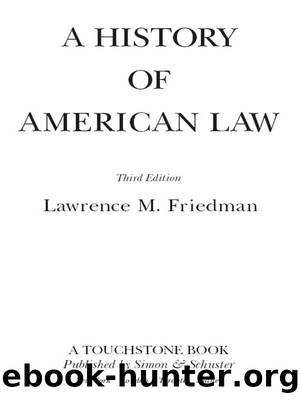A History of American Law by Lawrence M. Friedman

Author:Lawrence M. Friedman
Language: eng
Format: epub
Publisher: Touchstone
Published: 2005-12-14T16:00:00+00:00
Chapter 4
The Land and Other Property
The Transformation of Land Law
The dominant theme of American land law was that land should be freely bought and sold. For this reason, lawyers, judges, and legislaturesâand the landowning publicâhad gone to great pains, in the years after Independence, to untie the Gordian knots of English land law. Law had to fit the needs of those in a big, open country, who thought they lived in a land of abundance, a land with huge tracts of vacant land. (That there were native people living on some of this land was either ignored or ruthlessly dealt with.) For the settlers, land was the basis of wealth, the mother of resources and development. As the frontier moved farther west, land law followed at a respectable distance. The land itself was transformed from wilderness to farm or industrial land; from vacant sites to towns to cities. The land law, too, passed through phases of development. A state like New York had conditions different from Wyoming, and its land law reacted accordingly. Some of these differences in land and resource law, though never eliminated, tended to weaken over time. Colonial history in a way repeated itself; relatively rude, relatively simple land law, in the new settlements, changed to more complex, more sophisticated law, chiefly because more sophisticated law became more relevant to conditions.
For example, there was never much question that American law would absorb the concept of the fixture, with its attendant rules. A fixture is an object attached to the land. It is legally treated as part of the land. This means that sale of the land is automatically sale of its fixtures. A building is par excellence something attached to the land. Yet, in Wisconsin in the 1850s, a court decided in one case that a barn in Janesville, in another, the practice hall of the âPalmyra Brass Band,â were not fixtures at all, but chattels, that could be detached from the land.1 These were flimsy, temporary buildings; the cases simply recognized what was a local and transient condition.
Older doctrines did not last if they seemed not to fit the American ethos. The law of property became vigorously pro-enterprise: for example, the doctrine of nuisance in the late nineteenth century was bent to the needs of entrepreneurs who were using the land; private homeowners suffered.2 In England, âuninterrupted enjoymentâ could give a landowner an easement of light and air. In other words, a landowner whose land had a pleasant, open view had a right to keep things that way; he could block his neighbor from putting up a building that would block his view and impair this easement. Especially in towns and cities, this doctrine was out of placeâor so the courts thought. America was bent on economic growthâon trying to promote, not curb, the intensive use of land. Chancellor Kent thought the rule did not âreasonably or equitably applyâ¦to buildings on narrow lots in the rapidly growing cities in this country.â âMere continuance ofâ¦windows,â according to
Download
This site does not store any files on its server. We only index and link to content provided by other sites. Please contact the content providers to delete copyright contents if any and email us, we'll remove relevant links or contents immediately.
International Integration of the Brazilian Economy by Elias C. Grivoyannis(57275)
The Radium Girls by Kate Moore(10901)
Turbulence by E. J. Noyes(7031)
Nudge - Improving Decisions about Health, Wealth, and Happiness by Thaler Sunstein(6629)
The Black Swan by Nassim Nicholas Taleb(6182)
Pioneering Portfolio Management by David F. Swensen(5599)
Rich Dad Poor Dad by Robert T. Kiyosaki(5140)
Zero to One by Peter Thiel(4816)
Man-made Catastrophes and Risk Information Concealment by Dmitry Chernov & Didier Sornette(4728)
Secrecy World by Jake Bernstein(3773)
Millionaire: The Philanderer, Gambler, and Duelist Who Invented Modern Finance by Janet Gleeson(3565)
Skin in the Game by Nassim Nicholas Taleb(3455)
The Age of Surveillance Capitalism by Shoshana Zuboff(3411)
The Money Culture by Michael Lewis(3276)
Skin in the Game: Hidden Asymmetries in Daily Life by Nassim Nicholas Taleb(3259)
Bullshit Jobs by David Graeber(3171)
The Dhandho Investor by Mohnish Pabrai(3161)
The Wisdom of Finance by Mihir Desai(3069)
Blockchain Basics by Daniel Drescher(2883)
